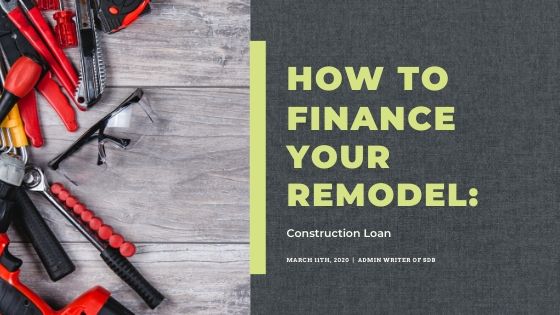
Updated: Oct 27th, 2020
What is the renovation boom of 2020?
The coronavirus has effectively changed the lives of all Americans, one of the common changes? Staying at home a little bit more. As current trends are stating, the average American is expected to stay in their home more frequently well after the initial waves of the pandemic. With remote work and distance learning a standard to daily life, everyone is staying comfy in their humble abodes. But this is the exact reason why we are seeing so many people opt to renovate their homes. Being home all the time; they see what needs improvements, they need a new space to do their work at home, they are home all the time so it is convenient. Pair any or all of these reasons with the fact there are historic lows in loan interest rates and you get the renovation boom of 2020.
Where to begin?
So you found the inspiration you have been looking for and decided on your newest project to jump on the renovation boom bandwagon. Or maybe you have been motivated to make your home a little more comfortable after being inside a little more than usual this year. Regardless of the reasons, whatever you have decided to whether it be a remodel, a whole entire renovation, or even a brand new addition; you are going to need money to fund the construction. But it’s not like you have thousands of dollars just lying around, right? So how do other property owners do it? There are many different options to fund your remodel, basement finish, bathroom renovation, or additions. You can take out a personal loan or make a new mortgage with the estimated costs bundled together or even seek financial assistance! But before you can do all that, you need to figure out where you stand financially and what you can achieve.
Find out how much Home YOU CAN AFFORD
You figured out what you have wanted to do for your home, now you need to establish a baseline of what that project is going to cost. Whether you hire a contractor or take on the work yourself, begin with an accurate estimate of what the project will cost.
Lenders will insist on a specific figure before they work with you. This can be a challenge as you will be forced to reach out to numerous different contractors who perform different trades. Unless of course, you are working with a design-builder, like SDB here, where they coordinate with their own tradespeople for you. Either way, you will have to collect bids for both labor and materials to prepare a ‘fairly accurate’ representation of the cost of construction. Then add on 10 percent for surprises. Then add a cushion of 20 to 30 percent to be safe.
Once you know how much you need to finance your home improvement project, how much will you get? Despite the promises and hype lenders make in their ads and promotional materials, how much you can borrow hinges on your credit rating, your loan-to-value ratio, your income, your home equity, and potentially the finished value of the property once the work has been completed.

-
Credit Ratings
Credit ratings are important in the loan process but in truth won’t likely affect your ability to receive funding. While an extremely poor credit rating might have you declined, the real importance is what kind of rates and terms that rating can offer you. Those who pay their debts on time with consistent payments over the last 12 months and not maxing out their credit lines will receive the best rates. However, your true buying potential is found by your Loan-to-Value ratio which will establish just how much debt you can take on to fund this home project.
.
Loan-to-Value Ratio
As mentioned earlier, lenders determine your buying potential by your loan-to-value ratio (LTV). This is a percentage of the appraisal value of your home. The standard limit for how much can borrow of that determined value is 80 percent and then subtracts the remaining balance owed on your current mortgage.
For example, for $125,000.00 home or value – you can borrow $100,000. Then, lenders subtract the mortgage balance from that amount to arrive at the maximum you can borrow. Assuming your balance is $60,000, the largest loan that you can obtain is $40,000 ($100,000-$60,000=$40,000). If you have a good credit rating, a lender might base your loan on more than 80 percent of the LTV; if you don’t, you might get only 65 to 70 percent. While many lenders go to 100 percent of the LTV, interest rates and fees soar at these higher ratios.
Other Factors
Your income. If you also have high expenses, a high-income level might not mean a larger loan. Most often, lenders follow two rules to minimize their risk:
- Your house payment and other debt should be below 36 percent of your gross monthly income.
- Your house payment alone (including principal, interest, taxes, and insurance) should be no more than 28 percent of your gross monthly income. The maximum debt-to-income ratio rises to 42 percent on second mortgages. Some lenders go even higher, though fees and rates get expensive — as will your monthly payment. However, a debt-to-income ratio of 38 percent probably is the highest you should consider carrying.
Interest rates. The less interest you pay, the more loan you can afford.
Loan term. The longer the loan, the lower the monthly payment. But total interest is much higher. That’s why you’ll pay far less for a 15-year loan than for a 30-year loan — if you can afford the higher monthly payments. The scope of the construction project will determine the necessary length of the loan.
Points. Each point is an up-front cost equal to 1 percent of the loan. Points are interest paid in advance, and they can lower monthly payments. But if your credit is less than perfect, you’ll probably have to pay points simply to get the loan. Every bank and financial institution charges different amounts for points; they can incorporate origination fees.

There is no one single answer
Like we have stated earlier, there are many options and choices for someone to fund their remodeling, renovation, addition, basement finishing, etc. It might seem overwhelming at first but their professionals will gladly show you the best options suited for your needs. Sustainable Design Build even has some companies we partner with and trust to work with our clients, so if you would we would be happy to let you know who we work with. But the main takeaway is, no matter the project there is a way to fund it the most efficient way possible.
*** Disclaimer – we are not a lending or financial service and thus this article is for general digest NOT accredited legal or Financial advice.


Recent Comments